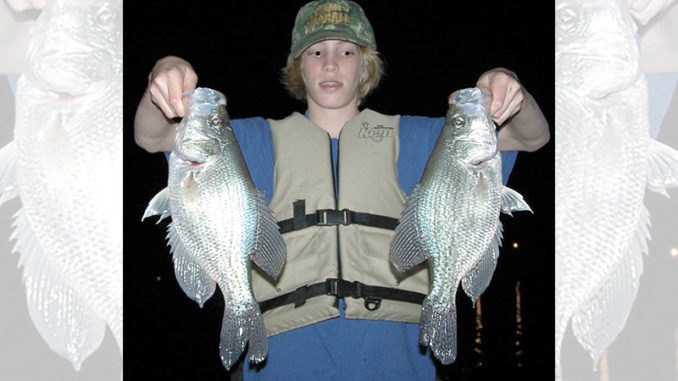
Think murky and shallow, and you’re halfway to figuring out crappie on this upstate reservoir.
South Carolina is home to a variety of lakes, rivers and impoundments that hold abundant numbers of crappie. A debate over South Carolina’s best crappie hotspots could rage on for hours. And only a very small number of people would put Lake Keowee at the top of their list.
Located in the upper northeast corner of the state on the border between Pickens and Oconee Counties, Lake Keowee is owned and operated by Duke Power Company. The agency uses the water from the lake to cool its fission reactors at the Oconee Nuclear Station.
The surrounding lakeshore is a mixture of controlled residential development and natural pine and hardwood landscapes at the foot of the Appalachian Mountains. The 18,500-acre lake is deep and clear. Average depths are in the 50- to 60-foot range.
For fishermen, none of those statistics are very exciting. But those crappie fishermen who live close by, like Alex Orr, have learned to make the best of the situation.
“Most of Keowee is too deep and too clear to consistently catch crappie in,” Orr said. “I also believe there are fewer crappie here than in other lakes like Greenwood or Murray. But on average, the crappie we catch at Keowee are bigger than those fish found at other places.”
Orr said that for a big reservoir, Keowee fishes small for crappie. He eliminates more than 90 percent of the lake by concentrating his efforts on several creek arms in its upper extremes.
Look for cover, or make your own
“The water is a lot murkier in the backs of places like Stamp Creek, Cane Creek, Little River and Crowe Creek,” he said. “It’s murkier than anywhere else on the lake. Crappie seem to be a lot more comfortable in the murkier water. And you get away from all the deep water by fishing for them in the backs of the creeks. Most of the water will only be about 20 feet deep.”
After honing in on the right water, Orr said the next most important factor for finding Keowee crappie is cover. He said the lake has plenty of rocky cover. But woody cover — the kind crappie prefer — is few and far between. That’s why he has spent so much time sinking his own cover in the lake.
“I have maybe 35 to 40 brushpiles that I have put out in this lake,” Orr said. “You can also look for some blowdowns or laydowns if they are in deep-enough water. And on occasion you might find a boat dock that has some brush around it. But for the most part, the homeowners on Keowee don’t fish, so don’t expect to see too many good docks.”
Orr has also made some seasonal discoveries about Keowee crappie. He used to think fish moved deep during the winter. But his experience is to the contrary. He favors fishing from November through February, when the fish move shallow. In cold weather, he’s more likely to find them holding around his brushpiles. More specifically, he finds them holding in the tops of his brushpiles. usually less than six feet below the surface.
Tops of brush piles are better than the bottom
“When I’m fishing, I move from brushpile to brushpile. I ease up to the spot and mark the brushpile on my sonar graph, then throw out a buoy marker. I fish four to six rods from rod holders spaced around the front of the boat,” he said. “When I make my brushpiles, the water might be 20 feet deep. But the brush will come to within 12 feet of the surface. Most of the time, I find crappie hanging over the top of the brush about halfway between, even during the dead of winter.”
Orr’s tactics require no special trick. For rods, he uses 6- to 7-foot ultralight spinning outfits with reels spooled with 6-pound test. He uses a split-shot weight and a No. 4 light-wire hook baited with a live minnow. He bumps around over the top of the brush with his trolling motor. And he staggers the depths of his baits to cover the water column from about four feet deep to the top of the brush, but never lower. That keeps him from hanging up. He reasons that the crappie either hold at the top of the brush, or they don’t mind darting out of the brush when there’s a lively bait just above them in the clear water.
“I normally get my limit of crappie during a trip,” Orr said. “Sometimes, I may have to fish several brushpiles to get it. The average crappie will be nine or 10 inches long and weigh ¾ to 1¼ pounds. I might catch one or two that go over two pounds, but I don’t catch a livewell full of them.”
Don’t overlook bridge pilings
Orr is not the only Keowee fisherman who used to hold a misconception about the places crappie will live during the winter months. Monty McGuffin, a guide and host of a local television show, made a startling discovery one blustery January day while filming an episode of The Carolina Outdoorsman Show. The day before the filming, he was motoring under a bridge and marked something on his depth finder. Dropping an underwater camera over the side, McGuffin saw slab crappie holding near the surface as far as the camera lens could see.
“The water was cold, down in the 40s, and crappie were spread out 12 feet down, suspending over water that was 80 feet deep,” he said. “I went back the next day. It was a school holiday, so we took Josh King, the son of a buddy. We loaded up on some really nice slab crappie and filmed the whole trip and made it into a show.”
McGuffin came away from the experience with an understanding that crappie don’t go as deep during the colder months, nor do they always have to be holding in brushpiles. In fact, he has had success targeting Keowee crappie around bridge pilings and drop offs. Especially those with overhead cover nearby, such as a boat dock.
Fishing vertically is also a good tactic when fish aren’t suspended
“I feel like crappie, being cold-blooded animals, congregate around those bridge pilings at Keowee because they absorb sunlight and heat the water up just a degree or two,” McGuffin said. “That comfort zone isn’t deep. It’s closer to the surface. The same could be said for fish suspended on a bright, sunny day. The sunlight warms the water, and crappie will be drawn closer to the surface to get to the warmer water. I especially like a boat dock that sticks out over a creek run. The fish will suspend over the ledge and use the dock to provide some protection from the sun. But that warmer layer will be near the surface.”
On days when crappie are not suspending over structure, McGuffin employs a vertical finesse tactic to lure fish out of hiding. He learned this tactic from Tom Mundy of Fish Stalker Lures.
“It requires the right tools, meaning a highly sensitive ultralight rod, 4-pound-test line and a 1 ½-inch Slabtail lure on a 1/32nd-ounce jighead,” McGuffin said. “Get right over the structure and lower the bait to the bottom, which on 4-pound test will take a while. Then, slowly reel the bait up to the surface about one foot every few seconds. The lure quivers in the water, and when it gets right in the face of a crappie, he can’t help but bite it.”

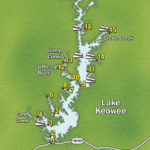
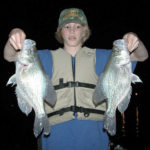
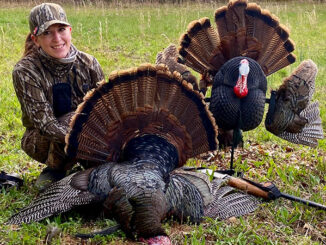
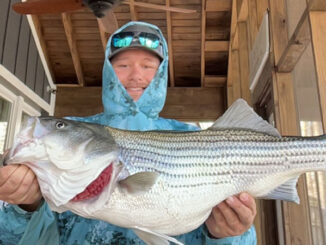
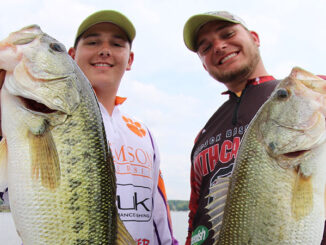

Be the first to comment